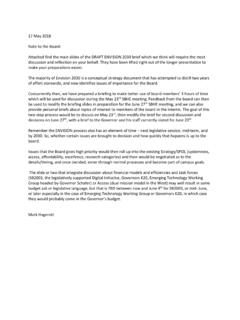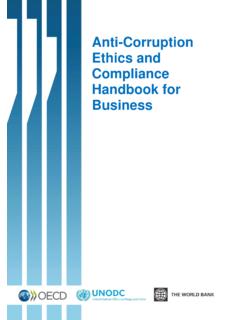Transcription of RISK TRANSFER MECHANISMS: CONVERGING …
1 RISK TRANSFER mechanisms : CONVERGING insurance , CREDIT AND CAPITAL MARKETS*. The purpose of the following article is to give a descriptive overview of the market for risk TRANSFER markets focusing on the growing inter-linkages between different financial sub-sectors such as banking and insurance . For the OECD, developments in TRANSFER risk markets are an area of particular interest as they represent cutting-edge technology of financial markets in recent years. Furthermore they represent one of the areas in focus following the large-scale uncertainties in the aftermath of September 11, collapse of Enron and default in Argentina1.
2 The paper contains five main sections. The first, introductory section motivates the interest for analysing the developments of markets, including the limitations of the study. The second section gives a description of the markets for risk TRANSFER focusing on the outstanding amounts and players active in markets. In section three a range of factors is listed, all of which underpin the development of risk TRANSFER markets. The fourth section focuses on wider financial stability issues with a special focus on supervisory and regulatory issues.
3 The fifth and final section comprises some concluding remarks and raises issues for further discussion. I. Introduction and summary Sophisticated securitisation methods to transform cashflows have expanded the scope for risk management practices in financial companies to a level where risk embedded in typical financial sector products such as corporate bonds, commercial loans and insurance can be repackaged into financial market securities. Many financial institutions and institutional investors have now become familiar with these tools (credit - and insurance - linked securities), * This article was prepared by Jens Verner Andersen, Economist in the Financial Affairs Division at Directorate of Financial, Fiscal and Enterprise affairs.
4 1. which shed risks from financial institution's balance sheets and TRANSFER them via capital markets to institutional investors. Some of these mechanisms -- credit derivatives -- have been developed to address credit risks in corporate bonds and bank loans whilst others, such as alternative risk TRANSFER products and catastrophe bonds, are specially designed to address insurance risks . As a by-product from growth in risk TRANSFER markets, greater inter-dependence between banks and insurance companies may have emerged thus bridging the two financial sectors and financial markets.
5 Banks are shifting credit risks from their balance sheets to insurance companies, amongst others, and insurance companies are issuing catastrophe bonds that are being sold to institutional investors such as investment funds and other end- investors. With higher activity in risk TRANSFER markets, financial market participants with traditional business lines could assume completely different roles as virtual insurers or virtual bankers . In particular, the non-standardised products used by market participants such as credit derivatives and catastrophe bonds would be at the core of this analysis.
6 More traditional financial products, mortgage back securities and traditional derivative products accounting for a larger part of the financial sectors activity would be only part of the analysis to the extent that they impose special risks in either banks or insurance companies2. Bridging individual financial sector institutions has been part of the financial sector landscape for some time with bancassurance groups being the most visible sign. Whereas bancassurance groups create visible interrelations, risk TRANSFER markets create interdependencies that are less transparent, which makes the tracking of counterparty exposures a challenging task.
7 Using risk TRANSFER markets has, however, theoretical appeal as institutions from which contracts and claims originate are not necessarily the institutions best suited to warehouse them. Therefore, in principle, risk TRANSFER markets can improve dispersion of risks by making the pool of unsystematic risk -- idiosyncratic risk that can be eliminated by appropriate diversification -- larger, thus potentially limiting individual institutions' exposures to specific risk related to geography, sector and size. Although risk TRANSFER markets have the potential to enhance financial stability by diffusing exposures, there are concerns that they may equally lead to more concentrated and non-transparent risks .
8 Especially, the fact that a limited number of key players hold a high market share has been mentioned as a cause for concern. Furthermore, on the demand side, market participants can be taking excessive risks in areas where they have less expertise in terms of management and pricing of risks . On the supply side, risk TRANSFER markets offer financial 2. companies opportunities to hedge risks that did not exist before, however, these instruments are also challenging as they involve new counterparty risks . While these negative effects are hypothetical and do not necessarily materialise, greater interdependence between financial market participants would certainly raise challenges for authorities in tracking exposures and in avoiding regulatory arbitrage.
9 Following the large-scale uncertainties surrounding financial market in 2001. authorities have expanded oversight with the functioning of risk TRANSFER markets. Regulators and supervisors have been particularly concerned with the fact that markets had grown very rapidly and not yet been tested during an economic slowdown. Recent default events such as the collapse of Enron, default in Argentina and other large corporate bankruptcies in the wake of the economic slowdown have provided an important test for risk TRANSFER markets.
10 Although the first observations indicate that markets for risk transfers have remained fairly resilient to the fallout and avoided systemic implications, there is still some wary regarding the risk going forward. This was indicated on the latest Banana Skin list -- a survey of the risks facing banks -- where complex financial instruments such as risk TRANSFER mechanism is one of the factors that has been racing up the league of perceived big risks for banks and is now regarded as the fourth largest risk factor among financial market participants 3.















